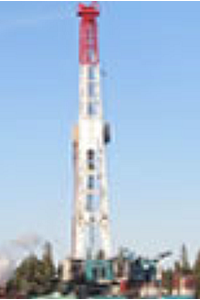Drilling mud sprays over worker and then ignites
Date of incident: October 2012
Notice of incident number: 2012170090170
Employer: Oil or gas drilling company
Incident summary
A worker was in a drilling rig's mud mixing shack while the rig was drilling ahead at a natural gas well. During normal drilling operations, the pop valve opened, which directed the drilling fluid (known as mud) to the pressure relief line. The pressure relief system included steel pipes as well as flexible hoses. A fitting on a high-pressure flexible hose broke where the hose was connected to the mud tank with a hammer union fitting. Mud sprayed from the broken hose onto the worker and the rig. A flash fire occurred, resulting in serious burns.
Investigation conclusions
Causes
- After a flexible hose failed, a worker was covered with oil-based drilling mud, which ignited and caused serious burns: The pop valve released and mud (drilling fluid) was directed to the pressure relief system. As a result of this single event overload, the high-pressure flexible hose fitting failed by a mechanism of brittle fracture. The worker was in close proximity to the failure point of the flexible hose on the pump's relief line. He was sprayed with a substantial amount of the mud, which soaked his personal protective clothing with combustible liquid. When the mud ignited, his fire-retardant clothing afforded only initial protection from the fire, and he was engulfed in flames, suffering severe burns.
Underlying factors
- The flexible hose was the incorrect length: The high-pressure flexible hose used on the pump's relief line was too long for the space between the modules so that it created a camel-back shape. This shape applied additional stress forces to the area of the hammer union fitting.
- The diameter of the piping was reduced downstream from the pressure relief device: The high-pressure flexible hose on the pump's relief line was 1 inch (2.5 centimetres) smaller in diameter than the piping downstream from the pop valve. This reduction in piping size created a restriction in the flow line that transferred additional force to the hammer union fitting when the pop valve was actuated.
- The metal hammer union hose fitting lacked toughness: The specified standard for the hose fitting was adequate for normal hydraulic use, but it was inadequate for the way in which the hose was used at this rig. As a result, the fitting was subjected to forces beyond its expected performance criteria, and a single-point failure occurred during the normal operation of the pop valve.
- Potential for ignition was high when the hose failed: The ignition of the aerosolized mud cloud was likely inevitable given the number of uncontrolled ignition sources present at the time of the incident. Although the exact ignition source could not be determined, several potential sources were identified:
- The improper electrical connection on the pump module was close to the failure point of the flexible hose and may have caused a spark.
- Sparks resulting from electrostatic discharge may have occurred. When the mud continued to travel at high velocity through the flexible hose after the break occurred, a strong electrostatic charge may have built up and sparked when discharged. Controlling this potential ignition source may not have been possible or practical.
- Metal-on-metal sparking may have occurred as a result of the metal hose fitting striking other metal parts as it flailed around. Controlling this potential ignition source may not have been possible or practical.
- Rig setup instructions and inspections were inadequate: The employer provided no written instructions about how to connect the rig's modules and install the high-pressure lines other than the rig layout diagram. Rig technicians relied on training by other workers or on their experiences with previous rig setups. The inspections conducted prior to drilling and after the rig was operational were not adequate to address the condition of the flexible high-pressure hoses. The incorrect length of the flexible hose and its smaller diameter were not identified as deficiencies during setup or during the drilling operation. The lack of written instructions for setting up the rig and the inadequate inspections resulted in the perpetuation of faulty connections between ancillary equipment modules.
- Personal protective equipment provided insufficient protection: The worker's fire-retardant clothing would likely have prevented injury from the thermal effects of the initial fireball. However, because the clothing was soaked in the combustible liquid mud, the performance of the material was compromised. The material did not self-extinguish and fire continued to burn after the worker self-rescued from the area.
- Mud flow was unchecked after the hose failed: The relief line was open and released high-pressure mud until one of the workers became aware of the problem and disengaged the mud pump supplying the pressure. The hose restraint in place did not include any sort of secondary control to mitigate the release of fluid from the broken hose as soon as it occurred. Enough mud was released to become aerosolized, and the combustible liquid was sprayed over a large area.
2021-04-22 20:42:33

